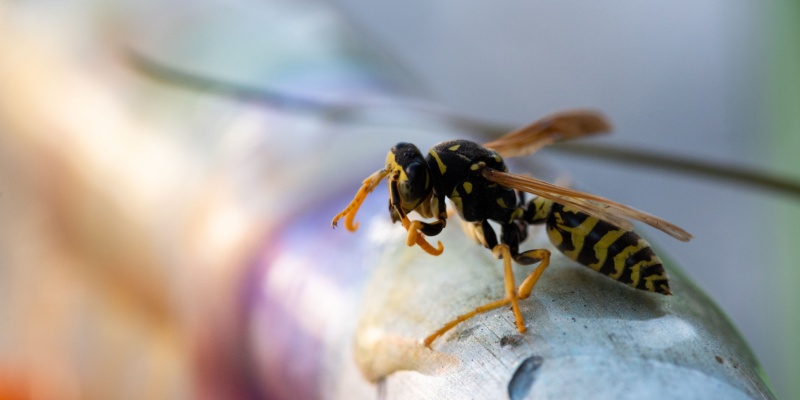If your backyard barbecue has ever been interrupted by aggressive buzzing, you’re not alone—yellow jackets in Maine are notorious for crashing summer plans. These stinging insects are especially active in warmer months, and for residents in York, ME, understanding what draws them in is key to avoiding unwanted encounters.
You might notice more activity in areas with increased outdoor moisture and food residue—factors that can quietly invite pests. Preventive pest control becomes crucial during the months when stinging insects thrive, especially in residential spaces surrounded by woods or near coastal areas.
What Attracts Yellow Jackets to Your Yard?
Yellow jackets aren’t just flying around aimlessly—they’re resourceful scavengers with specific preferences. Here’s what makes your yard their favorite hangout:
- Sweet Scents & Sugary Foods: They’re drawn to sugary drinks, ripe fruits, soda cans, and desserts left unattended.
- Protein Sources: Cooked meats, pet food, or even trash bins that haven’t been sealed properly.
- Uncovered Trash: Yellow jackets thrive near open garbage cans and compost piles.
- Standing Water: Birdbaths, clogged gutters, or poor drainage can create moist areas they seek.
- Floral Scents: Perfumes, air fresheners, and certain flowering plants mimic nectar.
- Outdoor Grills & Patios: Grease residue and food scraps become easy pickings.
- Warm, Hidden Spaces: Hollow logs, wall voids, and underground burrows provide nesting spots—yes, that includes the dreaded yellow jacket nest in ground.
These outdoor features may seem harmless, but they create an ideal setting for yellow jackets to feed, build nests, and establish territory. York residents often experience peak activity mid-summer when food availability and nesting options collide. Even a single spilled soda or an open trash can can set the stage for increased swarm activity, so paying attention to these attractants can make all the difference in keeping your outdoor spaces serene.
Nesting Behavior and Infestation Warning Signs
Unlike bees, yellow jackets build concealed nests that can go unnoticed until it’s too late. In York, ME, most nests are found beneath the surface: under mulch beds, behind retaining walls, or beneath eaves. A sudden swarm when mowing, walking near bushes, or grilling outdoors may point to an established yellow jacket infestation.
If you’ve seen persistent activity around one area, resist the urge to DIY. Disturbing a nest—even accidentally—can provoke aggressive swarming. That’s why many locals turn to pest control for yellow jackets in York, ME before the problem spirals.
What to Do If You Discover a Nest
Stumbling upon a yellow jacket nest in the ground—especially while gardening or doing yardwork—can be startling. These nests are often hidden, and unlike bees, yellow jackets can sting repeatedly and act aggressively when threatened. If you suspect a nest nearby, avoid mowing, trimming, or walking close to the area. Even vibrations from footsteps can trigger a defensive swarm.
The safest first move is to observe from a distance and note the patterns of entry and exit. This helps professionals identify the nest’s scope and activity level. While over-the-counter solutions might seem quick and cheap, they often lead to partial results and unnecessary risks. Atlantic Pest Control’s trained technicians in York, ME, are equipped to handle these nests with precision, especially when they’re embedded in walls or tucked underground.
For homeowners who want to protect kids, pets, and guests from surprise encounters, swift and professional intervention is your best defense. Yellow jackets are territorial and can become more aggressive over time—so even a minor delay could turn a small nest into a full-blown infestation.
How to Keep Yellow Jackets Away from Your Yard
While it’s tempting to rely solely on sprays or traps, long-term control comes from a multi-step strategy. Here are some natural ways to repel yellow jackets and reduce encounters:
- Seal all garbage tightly and rinse recyclables before disposal.
- Use essential oils like peppermint or clove as natural deterrents near entry points.
- Keep sugary drinks and meat covered when eating outside.
- Maintain screens and caulking around doors, vents, and windows.
- Install decoy nests—yellow jackets are territorial and often avoid areas they believe are already colonized.
- Remove fallen fruits from trees and clean up yard debris quickly.
- Schedule routine yard maintenance to detect early signs of nests
Each of these steps builds on the others to form a comprehensive approach that helps keep yellow jackets at bay. Natural methods not only minimize environmental impact—they also make your yard less enticing to curious scouts looking for new territory. The key is consistency: when these deterrents become part of your regular outdoor routine, you’re reducing the risk of attraction and infestation without resorting to harsh chemicals.
Choose the Experts in Maine for Stinging Insect Protection
Don’t let buzzing swarms define your season. Yellow jackets can be aggressive and unpredictable, but Atlantic Pest Control has the experience and tools to keep them at bay. Our customized solutions help Maine homeowners maintain safe, pest-free environments long after the first treatment.
No two yards—and no two infestations—are exactly alike. That’s why our approach begins with understanding your property, its layout, and the environmental factors that contribute to yellow jacket activity. Whether you’re near wooded trails or coastal breezes in York, our technicians build a pest management plan tailored to your home’s specific challenges. We craft pest solutions with precision, so your home gets exactly the treatment it deserves.
We’re locally owned, deeply rooted in our community, and committed to eco-friendly practices that protect your environment while keeping pests out. Enjoy your home again with customized, eco-friendly pest solutions. Contact Atlantic Pest Control today.
